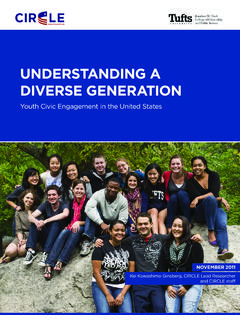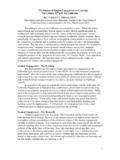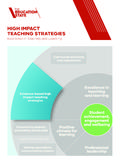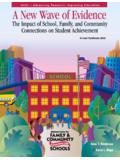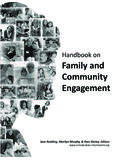Transcription of YOUNG VOTER MOBILIZATION TACTICS - …
1 YOUNGVOTERMOBILIZATIONTACTICSA compilation of the most recent research ontraditional & innovative VOTER turnout techniquesWinning YOUNG VotersThis booklet outlines the best ways to reach and turn out YOUNG voters, fromphone banks to door knocks. Each tactic is evaluated through a randomizedfield experiment in order to determine how much that tactic increases a person slikelihood to vote and for its cost-effectiveness. We also outline what does notwork and is not worth a campaign s time or saw in 2004 that YOUNG people will vote when asked. This booklet gives non-profits and political campaigns the tools to turn out YOUNG voters in 2006and ThemesThemes from the research findings ..5 Case Studies on Turnout TechniquesResearch case studies by tactic (with impact & costs analyses) ..9 Tips for campaignsAdvice based on the research findings ..20 YOUNG VOTER Strategies, a project of the Graduate School of Political Managementat The George Washington University with support from The Pew CharitableTrusts, provides the public, parties, candidates, consultants and nonprofits withdata on the youth vote and tools to effectively mobilize this electorate forupcoming compilation of the most recent academic research on VOTER mobilizationtechniques is one of many toolkits that YOUNG VOTER Strategies has developed to assist campaigns and organizations in developing their own strategies forengaging the increasingly large youth more information about past reports and upcoming research please visit ourwebsite at booklet was compiled with the help of CIRCLE ( The Center for Informationand Research on Civic Learning and Engagement) at the University of promotes research on the civic and political engagement of Americansbetween the ages of 15 and 25.
2 Although CIRCLE conducts and funds research,not practice, the projects that they support have practical implications for thosewho work to increase YOUNG people s engagement in politics and civic life. CIRCLEis also a clearinghouse for relevant information and scholarship. CIRCLE is fundedby The Pew Charitable Trusts and Carnegie Corporation of New this booklet we have compiled the best and most recent randomized fieldexperiments done on traditional and innovative campaign TACTICS . For eachtactic, we estimate the cost per additional vote and the impact on youngvoters turnout. We start with themes that run through the most successfulturnout tests and end with tips for putting these most effective TACTICS intopractice. We hope you will use this information to better incorporate youngvoters into your campaign plans in the is a randomized field experiment?The community of non-partisan and partisan organizations, foundations andresearchers dedicated to engaging YOUNG voters has been conducting randomizedfield experiments for more than six years to study various types of VOTER contactand quantify their impact .
3 The Pew Charitable Trusts has funded most of thisresearch, conducted in conjunction with scholars at Yale University. In 2004, theBeldon Fund, JEHT Foundation, Carnegie Corporation of New York, and SolidagoFoundation funded additional experiements through CIRCLE. Meanwhile, in2004, The Student PIRGs New Voters Project successfully implemented and tookto scale many findings from the research to randomized field experiments are essentially like running prescription drugtrials for politics, where people in a treatment group get a knock on the door or a phone call and people in the control group do not. After the elections, countyrecords are collected to find out at what rate the treatment and the control groupsvoted and to determine the impact of the door knocking or phone results mean that organizers for youth vote campaigns and politicalcampaigns can predict with reliability the results of their Out YOUNG VotersIn 2004, YOUNG VOTER turnout increased more than in any election since 18 yearolds won the right to vote 35 years ago.
4 Turnout among our nation s youngestvoters ages 18-24 increased 11 percentage points from 36 percent to 47 percent;turnout among 18-29 year olds increased 9 points from 40 percent to 49 percent.( Census Bureau 2005)This trend continued in 2005 when student-dense precincts in Virginia saw aturnout increase of 15 percent. (New Voters Project and CIRCLE 2005)Leading campaign professionals, analysts and academics agree that one of the keyfactors driving this recent increase in turnout is that there has been, for the firsttime in decades, a major investment in mobilizing these voters. Non-partisanorganizations that ran peer-to-peer field operations, media, and visibilitycampaigns spent an estimated $40 million on registering and turning out youngvoters, a presidential campaign made a media buy targeting YOUNG voters, andpartisan organizations both inside and outside of the party structures mobilizedsupportive turnout efforts paid off on Election Day 2004 as more than 20 million 18-29 year old voters went to the lesson learned is that today s YOUNG adults are an engaged generation thatwill vote in higher numbers if they are asked.
5 Given their sheer size topping 42million in 2006 and growing rapidly it is a crucial demographic to engage andask to vote. The question now is the most cost-effective wayto ask a YOUNG person to vote?5 Quality countsActual votes per contact will be higher when the contact is more personalizedand research shows that the most effective method of generating a new voteris an in-person door knock by a peer. The next greatest impact was seen byphonebanks with longer, chattier phone scripts or volunteers making thecalls. Also, recent survey data by YOUNG VOTER Strategies shows that the onlinetools that are most effective are the ones where the YOUNG VOTER either opts-into the conversation or gets to interact in some Section II case studies demonstrate that the less personal and interactiveoutreach TACTICS are, the less effective they are in turning out voters. Onestudy (Ram rez 2005) allows a direct comparison between volunteer phonebanks, direct mail, and robocalls.
6 The volunteer phone banks are ten timesmore cost-effective than the automated phone calls or robocalls. Begin with the basicsYoung people need nuts-and-bolts practical information about how to efforts that make voting more convenient are quite experiment in which high school students were taught to use a votingmachine raised turnout dramatically. As Elizabeth Addonizio writes, thisprogram increased the probability that an 18-year-old will vote by 19 to 24percentage points. (Addonizion forthcoming) Another experiment whichsimply reminded voters to go to the polls on Election Day and providedpolling place information in New Jersey in 2003 resulted in turnoutincreasing by almost 14 points. (Green 2004)Also, the research findings illustrate that efforts to make the voting processeasier increase turnout in cost-effective ways. An absentee ballot requestmailer generated additional votes at $8 per vote for voters under 30, asignificantly more efficient impact than with older voters.
7 (Mann 2006)5 Section I: Key ThemesWe found several key themes that dominate the research findings. These themes help explain how to effectively turn out new YOUNG voters who would not otherwise go to the and immigrant youth are cost-effective targetsWhen targeting ethnic or immigrant communities, it is cost-effective totarget YOUNG voters, particularly because there is less need to translatematerials into languages other than working in ethnic or immigrant communities, be sure to ask all votersyou contact to volunteer to reach out to their neighbors: research alsoindicates that in ethnic and immigrant communities the most trustedmessenger is someone who looks like the potential VOTER . (Michelson 2004)This is the case with most voters, but even more so in these , youth are at least as easy to reach as older voters. Latino 18-29 year-oldsare easier to reach than those in the 30-39 age range and the same as 40-59year-old Latinos.
8 For Asians, YOUNG voters were less likely to be contactedthan the older Asian-American voters but as easy to contact as those in the30-49 age ranges. (Ram rez and Wong 2006)Initial MOBILIZATION makes for repeat votersSuccessful MOBILIZATION in one election raises people's propensity to vote insubsequent elections. Parties, candidates and interest groups should expectlong-term benefits from mobilizing youth one study, the authors found that 50 percent of the effect of canvassingduring the 1998 New Haven election persisted in 1999, even though therewere no additional efforts to get out the vote. (Gerber, Green, and Shachar2003) Another influential study (based on survey research, not experiments)found that once people begin to vote, their propensity to participate in futureelections rises. (Plutzer 2002) Finally, a new study that tracked 10 canvassingexperiments over time indicate that voting is habit- forming. The study foundthat if you get a person to vote in one election, they will be 29 percentagepoints more likely to vote in the next election.
9 (Nickerson 2004)Studies conducted in previous decades found that adults party identificationwas remarkably stable over the course of their lives. If these patterns persist inthe current era, then the odds are high that someone who is mobilized to votefor a particular party will continue to vote for that party for decades to come.(Sears and Levy 2003, p. 79) The medium matters more than the messageTo date, the growing body of experimental research has not found that anytype of message works better than another. It is more about making aquality studies have varied the message to compare partisan versusnonpartisan or negative versus positive content. None of these studies haveshown a significant impact difference between messages. (Arceneaux andNickerson 2005; McNulty 2005; Nickerson, Friedrich, and King 2006;Panagopoulos 2006) YOUNG people are easy to incorporate into your lists andturnout programsExcluding YOUNG voters from your turnout efforts is a mistake.
10 The researchfindings all demonstrate that YOUNG people are just as responsive to votercontact as older voters.(Nickerson, forthcoming)While voters under 30 respond to turnout TACTICS at the same rates as oldervoters, in some communities they are more difficult to reach, so targetingmust take this into consideration. Efforts in ethnic communities found youngpeople as easy to reach as older voters, and student areas and apartmentbuilding have dense residences that lead to very high contact has the greatest impact on turning out YOUNG people to between $11 and $14, you can get to the polls a new VOTER that would nothave otherwise voted. Overall, we consistently found a 7 to 10 percentagepoint increase among YOUNG voters contacted through a door-to-door canvass a good reason to keep YOUNG voters on your walk lists. Canvassing isespecially beneficial in dense student neighborhoods and apartment buildingswhere you can reach more people in less time, helping keep costs Door-to-Door CanvassingCost per additional vote :$ :Canvassing by a candidate in an open county seat during spring2004 Democratic primary elections in Bernalillo County, NM.

